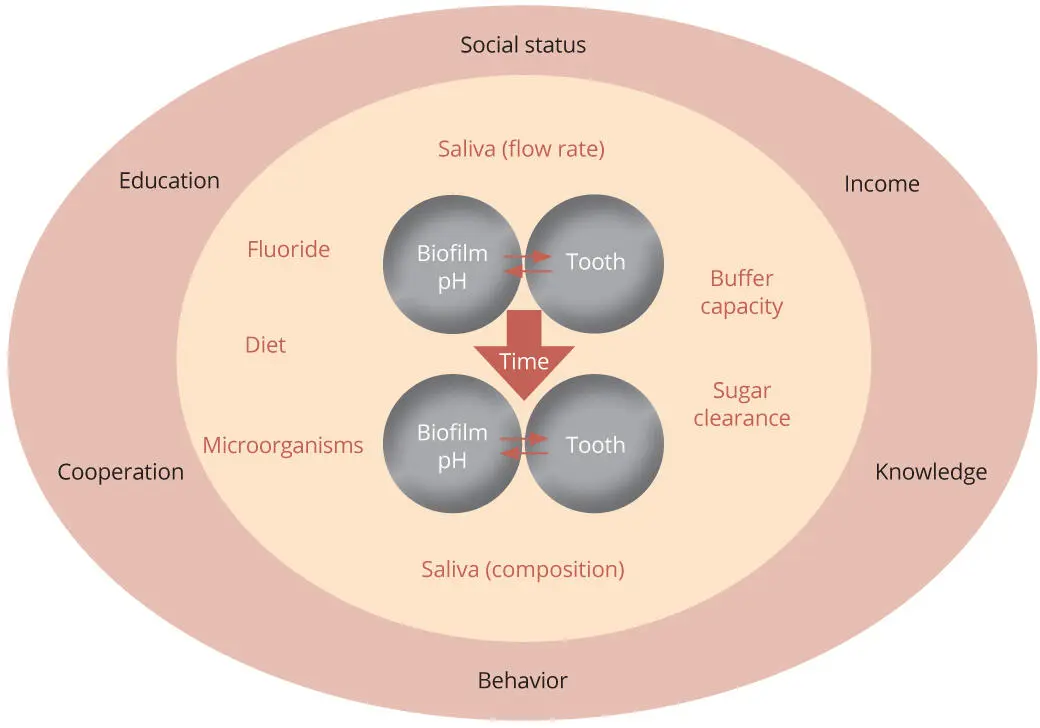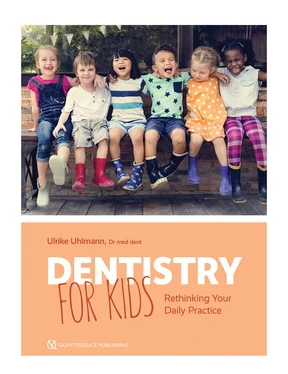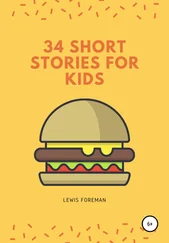MINERALIZATION AND ERUPTION TIMES
To understand disorders such as hypomineralization or dental fluorosis, we need to know exactly when primary and permanent teeth are mineralized ( Tables 1-1and 1-2). Furthermore, when assessing radiographs in the mixed dentition, it can be helpful to know when the dental crowns of the permanent premolars or molars should be visible so that any agenesis can be diagnosed. Table 1-3shows the eruption times of the primary and permanent teeth. It should be noted that relatively wide variations in these timings are possible; those listed in the table should only serve as a guide.
TABLE 1-1 Mineralization times of the primary teeth 4
| Tooth |
Start of mineralization |
End of mineralization |
Root fully developed |
| Incisors |
3–5 months in utero |
4–5 months postnatal |
1.5–2 years |
| Canines |
5 months in utero |
9 months postnatal |
2.5–3 years |
| Primary first molar |
5 months in utero |
6 months postnatal |
2–2.75 years |
| Primary second molar |
6–7 months in utero |
10−12 months postnatal |
3 years |
TABLE 1-2 Mineralization times of the permanent teeth 4
| Tooth |
Start of mineralization |
Crown fully developed |
Root fully developed |
| Maxilla |
|
|
|
| Central incisor |
3–4 months |
4–5 years |
10 years |
| Lateral incisor |
Up to 1 year |
4–5 years |
11 years |
| Canine |
4–5 months |
6–7 years |
13–15 years |
| First premolar |
1.5–1.75 years |
5–6 years |
13–15 years |
| Second premolar |
2–2.25 years |
6–7 years |
12–14 years |
| First molar |
At birth |
2.5–3 years |
9–10 years |
| Second molar |
2.5–3 years |
7–8 years |
14–16 years |
| Third molar |
7–9 years |
12–16 years |
18–25 years |
| Mandible |
|
|
|
| Central incisor |
3–4 months |
4–5 years |
9 years |
| Lateral incisor |
3–4 months |
4–5 years |
10 years |
| Canine |
4–5 months |
6–7 years |
12–14 years |
| First premolar |
1.75–2 years |
5–6 years |
13 years |
| Second premolar |
2.25–2.5 years |
6–7 years |
13–14 years |
| First molar |
At birth |
2.5–3 years |
9–10 years |
| Second molar |
2.5–3 years |
7–8 years |
14–15 years |
| Third molar |
8–10 years |
12–16 years |
18–25 years |
TABLE 1-3 Eruption times of the primary and permanent teeth *
| Tooth |
Eruption times |
| Primary |
|
| Central incisor |
6–8 months |
| Lateral incisor |
8–12 months |
| First molar |
12–16 months |
| Canine |
16–20 months |
| Second molar |
20–30 months |
| Permanent |
|
| First molar (6-year molar) |
5–7 years |
| Central incisor |
6–8 years |
| Lateral incisor |
7–9 years |
| Canines and premolars |
9–12 years |
| Second molar (12-year molar) |
11–14 years |
| Third molar (wisdom tooth) |
16+ years |
*Relatively wide variations in these timings are possible.
CARIES AS A MULTIFACTORIAL DISEASE
Because caries is a multifactorial disease, it is up to the clinician to identify each patient’s individual risk factors and intervene preventively and therapeutically in a targeted way. Especially in children who have no influence on their own diet and oral hygiene, it is important to identify all the etiologic factors contributing to the caries so that adjustments can be made, provided the parents are compliant and reliable, to achieve a lasting reduction of the risk of caries. Figure 1-4 represents the caries etiology model 5according to Fejerskov and Kidd, illustrating the various key components and their interactions for the purpose of successful caries assessment.

Fig 1-4 Multifactorial etiology model of the development of caries.
REFERENCES
1.Müller EM, Hasslinger Y. Sprechen Sie schon Kind?: Prophylaxe auf Augenhöe. Berlin: Quintessenz, 2016.
2.Ermler R. Diagnostik von Approximalkaries bei Milchmolaren mit Hilfe des DIAGNOdent pen. Berlin: Charité, Universitätsmedizin Berlin, 2009.
3.van Waes H, Stöckli P (eds). Kinderzahnmedizin, Farbatlanten der Zahnmedizin. Stuttgart: Thieme, 2001.
4.Mittelsdorf A. Kariesprävention mit Fluoriden – Eine Fragebogenaktion zur Fluoridverordnung in Berliner Kinderarztpraxen unter besonderer Berücksichtigung der Empfehlungen der DGZMK. Berlin: Charité, Universitätsmedizin Berlin, 2010.
5.Kühnisch J, Hickel R, Heinrich-Weltzien R. Kariesrisiko und Kariesaktivität. Quintessenz 2010;61:271–280.
2SUCCESSFUL COMMUNICATION WITH KIDS AND PARENTS
“The use of humor in pediatric dentistry is highly recommended. It may be used to facilitate communications with patients and parents, alleviate patient anxiety, and assist the dentist in coping with stress associated with the practice of dentistry.”
MOSTOFSKY AND FORTUNE 1
Communication with your pediatric patient begins not when the treatment starts but as soon as the child enters the dental practice. Communication is not merely about talking; it includes a plethora of nonverbal signals. American-Austrian psychologist Paul Watzlawick expressed this clearly when he said “You cannot not communicate.” Communication consists of 55% nonverbal cues (gestures and facial expressions), 38% tone of voice, and only 7% actual content of what is said. 2This chapter examines the different levels of communication and their importance in the dental practice. Suggestions are then given regarding how to use verbal and nonverbal language to gain, improve, or maintain compliance for different types of pediatric patients.
IMPORTANCE OF CHILD-APPROPRIATE ENVIRONMENT
Children need to be engaged to feel comfortable in any public space. General dentistry practices without a specialization in pediatric treatment can create a child-friendly environment with just a few resources. To do this, it is helpful and necessary to visualize the viewpoint of a child; they first see what is at their eye level or below it. Pictures, wall stickers, or even toys in the waiting room should be placed at a height where children can see and reach. A coloring table, some well-chosen books, and a set of building blocks are sufficient to create an engaging environment for children. If space is a concern, there are also some brilliant space-saving play alternatives, such as wall-mounted drawing boards, magnetic boards, jigsaw puzzles, or games. Wooden toys are often a more robust and durable choice. In the interests of other patients and the practice team, toys that emit sounds are inadvisable. When selecting toys for a common space, consider the cleansability; toys that are hard to sanitize may prove poor choices during flu season. In addition, wall decals are a useful and variable design feature for the waiting room or a treatment room because they are easy to remove without leaving a mark.
Читать дальше













